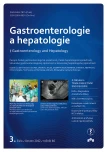Correlation of indications for pancreatic resection with histopathological finding
Authors:
A. Pulkertová 1; J. Špičák 1; V. Gábriš 2; D. Kautznerová 3; M. Kučera 4; M. Oliverius 4
Authors‘ workplace:
Klinika hepatogastroenterologie, IKEM, Praha, 2Pracoviště klinické a transplantační patologie, IKEM, Praha, 3Pracoviště radiodiagnostiky a intervenční radiologie, IKEM, Praha, 4Klinika transplantační chirurgie, IKEM, Praha
1
Published in:
Gastroent Hepatol 2012; 66(3): 191-195
Category:
Clinical and Experimental Gastroenterology: Original Article
Overview
Diagnosing malignant and benign diseases of the pancreas is a major problem due to the following differing treatment strategies. Surgical treatment is essential for resecable pancreatic adenocarcinoma and it is not indicated for locally advanced or metastatic lesions or for benign tumours. In chronic pancreatitis surgery is indicated only in certain cases. It is common that histopathological findings significantly correct prior diagnosis. The aim of this study was to identify the correlation of clinical and histopathological diagnoses.
Methods:
We retrospectively analyzed a set of patients who had undergone pancreatic resection at the Institute for Clinical and Experimental Medicine without taking the previous indication into consideration and compared the clinical and histopathological diagnoses.
Results:
The most common indication for surgery was the suspicion of malignant focal process in pancreatic parenchyma (220 of 362; 61%). This finding was confirmed in 133 of them (60%). Especially the evaluated tumour of Vater’s ampulla was an indication for surgery in 48 patients and confirmed in 33 (69%) of them. 59 (16%) patients were indicated for surgery for complications of chronic pancreatitis: the diagnosis was confirmed in 44 (74%) of them, while in 12 (20%) of them a malignant tumour was detected. Autoimmune pancreatitis was diagnosed in 14 (4%) cases, 11 of them were indicated for surgery due to suspicion of malignancy. The overall indication correlated with the histopathological finding only in 189 (52%) cases.
Conclusion:
Discrepancies between preoperative diagnosis and definitive histopathological conclusion were frequent. Autoimmune pancreatitis was not an exceptional (false) indication for surgery. It is necessary to refine and systematize the preoperative examination.
Key words:
autoimmune pancreatitis – chronic pancreatitis – pancreatic malignancy – pancreatic resection
Sources
1. Ryska M, Bělina F. Chirurgie pankreatu. Postgraduální medicína 2005; 7(4): 249–256.
2. Beger HG, Rau B, Gansauge F et al. Treatment of pancreatic cancer: challenge of the facts. World J Surg 2003; 27(10): 1075–1084.
3. Jemal A, Murray T, Samuels A et al. Cancer Statistics 2003. CA CancerJ Clin 2003; 53(1): 5–26.
4. Bilimoria KY, Bentrem DJ, Ko CY et al. National failure to operate on early stage pancreatic cancer. Ann Surg 2007; 246(2): 173–180.
5. Varga M, Oliverius M, Valsamis A et al. Pancreatic resection for metastatic renal cell carcinoma. Klin Oncol 2009; 22(6): 288–290.
6. Fitzgerald T, Hickner Z, Schmitz M et al. Increasing incidence of nonfunctional neuroendocrine tumors of the pancreas. American Society of Clinical Oncology Gastrointestinal Cancers Symposium. Orlando, FL, 2007.
7. Nayer H, Weir EG, Sheth S et al. Primary pancreatic lymphoma. Cancer 2004; 102(5): 315–321.
8. Hlavsa J, Man M, Kala Z et al. Nádory pankreatu. Med pro praxi 2008; 5(10): 388–392.
9. Mizukami H, Yajima N, Wada R et al. Pancreatic malignant fibrous histiocytoma, inflammatory myofibroblastic tumor, and inflammatory pseudotumor related to autoimmune pancreatitis: characterization and differential diagnosis. Virchows Arch 2006; 448(5): 552–560.
10. Dítě P, Ševčíková A, Novotný I et al. Autoimunní pankreatitida v České republice – region jižní Morava. Čes a Slov Gastroent a Hepatol 2007; 61(2): 82–85.
11. Pauser U, Kosmahl M, Kruslin B et al. Pancreatic solid and cystic hamartoma in adults: characterization of a new tumorous lesion. Am J Surg Pathol 2005; 29(6): 797–800.
12. Delbeke D, Pinson CW. Pancreatic Tumors: Role of Imaging in the Diagnosis, Staging and Treatment. J Hepatobiliary Pancreat Surg 2004; 11(1): 4–10.
13. Noh KW, Wallace MB. EUS-FNA in Diagnosis and Staging of Pancreatic Adenocarcinoma: EUS-FNA in Pancreatic Malignancy. Medscape General Medicine 2005; 7(2): 15.
14. Bedi MM, Gandhi MD, Jacob G et al. CA19-9 to Differentiate Benign and Malignit Masses in Chronic Pancreatitis: Is There Any Benefit? Indian J Gastroenterol 2009; 28(1): 24–27.
15. Slesak B, Harlozinska-Szmyrka A, Knast W et al. Tissue Polypetide Specific Antigen, a Marker for Differentiation between Pancreatic Carcinoma and Chronic Pancreatitis. Cancer 2000; 89(1): 83–88.
16. Gansauge F, Gansauge S, Parker N et al. CAM 17.1 – A New Diagnostic Marker in Pancreatic Cancer. Br J Cancer 1996; 74(12): 1997–2002.
17. Oliverius M, Kala Z, Varga M et al. Radical surgery for pancreatic malignancy in the elderly. Pancreatology 2010; 10(4): 499–502.
Labels
Paediatric gastroenterology Gastroenterology and hepatology SurgeryArticle was published in
Gastroenterology and Hepatology

2012 Issue 3
Most read in this issue
- Moviprep® – a modern bowel cleansing before procedures
- Antibiotic prophylaxis with acute pancreatitis
- Primary sclerosing cholangitis in patients with inflammatory bowel disease
- Combination of water immersion and carbon dioxide insufflation reduces discomfort associated with colonoscopy
